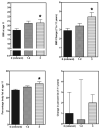Cross-sectional and longitudinal associations between TV viewing and girls' body mass index, overweight status, and percentage of body fat
- PMID: 16860123
- PMCID: PMC2562303
- DOI: 10.1016/j.jpeds.2006.02.003
Cross-sectional and longitudinal associations between TV viewing and girls' body mass index, overweight status, and percentage of body fat
Abstract
Objective: To assess cross-sectional and longitudinal relations between television (TV) viewing and girls' body mass index (BMI), weight status, and percentage of body fat.
Study design: Participants included 169 girls who were measured at ages 7, 9, and 11 years. Height and weight were measured and used to calculate girls' BMI and to classify their weight status. Girls' percentage of body fat was assessed with the use of dual-energy x-ray absorptiometry. Mothers reported the hours per day that girls watched TV on a typical day.
Results: No significant cross-sectional associations were identified. Results from longitudinal analyses showed that in comparison to girls who never exceeded the American Academy of Pediatrics TV viewing recommendations (ie, watched </= 2 hours of TV per day), girls who exceeded recommendations at ages 7, 9, and 11 years were 13.2 times more likely be overweight at age 11, were 4.7 times more likely to become overweight between ages 7 and 11, had significantly higher BMI and percentage body fat at age 11, and exhibited significantly greater increases in BMI between ages 7 and 11.
Conclusions: Interventions that target reductions in TV viewing among 7- to 11-year-old girls may help to reduce their risk of weight gain during late childhood.
Figures

Comment in
-
Evidence-based medicine and the obesogenic environment.J Pediatr. 2006 Jul;149(1):5-6. doi: 10.1016/j.jpeds.2006.03.038. J Pediatr. 2006. PMID: 16860113 No abstract available.
Similar articles
-
Longitudinal associations between television viewing and body mass index among white and black girls.J Adolesc Health. 2007 Dec;41(6):544-50. doi: 10.1016/j.jadohealth.2007.04.018. Epub 2007 Jul 20. J Adolesc Health. 2007. PMID: 18023782 Free PMC article.
-
Links between parents' and girls' television viewing behaviors: a longitudinal examination.J Pediatr. 2005 Oct;147(4):436-42. doi: 10.1016/j.jpeds.2005.05.002. J Pediatr. 2005. PMID: 16227026 Free PMC article.
-
Overweight in children and adolescents associated with TV viewing and parental weight: Project HeartBeat!Am J Prev Med. 2009 Jul;37(1 Suppl):S50-5. doi: 10.1016/j.amepre.2009.04.017. Am J Prev Med. 2009. PMID: 19524156 Free PMC article.
-
Familial correlates of adolescent girls' physical activity, television use, dietary intake, weight, and body composition.Int J Behav Nutr Phys Act. 2011 Mar 31;8:25. doi: 10.1186/1479-5868-8-25. Int J Behav Nutr Phys Act. 2011. PMID: 21453516 Free PMC article.
-
Parental weight status and girls' television viewing, snacking, and body mass indexes.Obes Res. 2003 Jan;11(1):143-51. doi: 10.1038/oby.2003.23. Obes Res. 2003. PMID: 12529497 Free PMC article.
Cited by
-
The chronobiology, etiology and pathophysiology of obesity.Int J Obes (Lond). 2010 Dec;34(12):1667-83. doi: 10.1038/ijo.2010.118. Epub 2010 Jun 22. Int J Obes (Lond). 2010. PMID: 20567242 Free PMC article. Review.
-
Translating research on healthy lifestyles for children: meeting the needs of diverse populations.Nurs Clin North Am. 2008 Sep;43(3):397-417, ix. doi: 10.1016/j.cnur.2008.04.001. Nurs Clin North Am. 2008. PMID: 18674672 Free PMC article. Review.
-
Longitudinal associations between television viewing and body mass index among white and black girls.J Adolesc Health. 2007 Dec;41(6):544-50. doi: 10.1016/j.jadohealth.2007.04.018. Epub 2007 Jul 20. J Adolesc Health. 2007. PMID: 18023782 Free PMC article.
-
Television viewing and sleep are associated with overweight among urban and semi-urban South Indian children.Nutr J. 2007 Sep 20;6:25. doi: 10.1186/1475-2891-6-25. Nutr J. 2007. PMID: 17880729 Free PMC article.
-
Use of television, videogames, and computer among children and adolescents in Italy.BMC Public Health. 2009 May 13;9:139. doi: 10.1186/1471-2458-9-139. BMC Public Health. 2009. PMID: 19439070 Free PMC article.
References
-
- Biddle SJH, Sallis JF, Cavill NE. Young people and health enhancing physical activity: evidence and implications. Health Education Authority; London: 1998. Young and active?
-
- Flegal KM. The obesity epidemic in children and adults: current evidence and research issues. Med Sci Sports Exerc. 1999;31(Suppl 11):S509–14. - PubMed
-
- Reilly JJ, Dorosty AR. Epidemic of obesity in UK children. Lancet. 1999;27:354–9. - PubMed
-
- Troiano RP, Flegal KM, Kuczmarski RJ, Campbell SM, Johnson CL. Overweight prevalence and trends for children and adolescents. Arch Pediatr Adolesc Med. 1995;149:1085–91. - PubMed
Publication types
MeSH terms
Grants and funding
LinkOut - more resources
Full Text Sources
Medical

